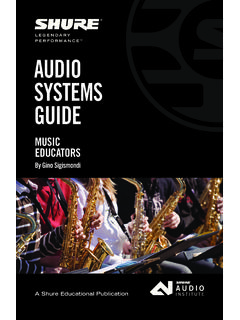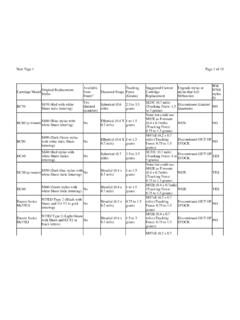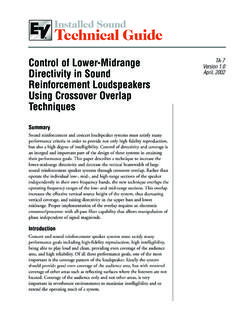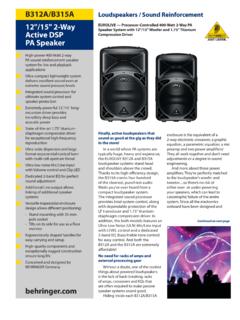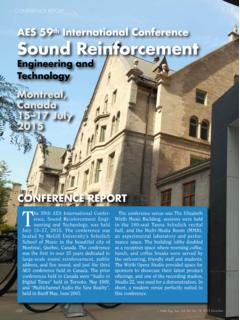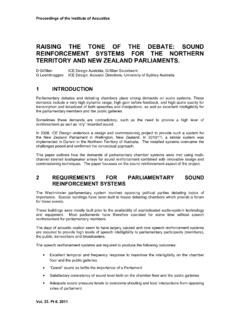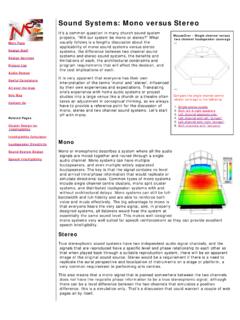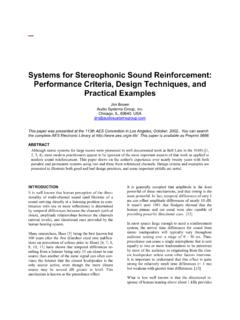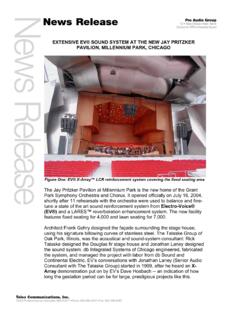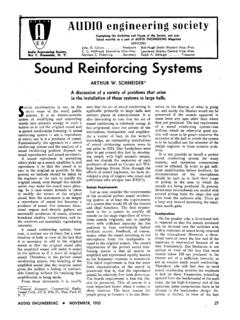Transcription of Shure Introduction to Recording and Sound …
1 A Shure Educational PublicationINTRODUCTIONRECORDING AND Sound REINFORCEMENTBy Gino SigismondiRecording and Sound ReinforcementRECORDING AND Sound REINFORCEMENTI ntroduction to3 Introduction .. 4 Recording .. 5 The Parts of a Recording System .. 5 Microphones .. 5 Recording Devices .. 11 Mixers .. 11 Hooking it up .. 12 Sound reinforcement for Music .. 12A Basic Sound System .. 12 Microphones .. 13 Mixers, Amplifiers and Loudspeakers .. 17 Signal Processors .. 19 Hooking it up .. 22 Sound reinforcement for Theater .. 23 The Realities of Theater Sound .. 23 Lavalier Microphone Techniques for Theater .. 25 Summary .. 27 Recommended Shure Microphone Models .. 28 Appendix .. 29 About the Author .. 29 Glossary .. 30 Table of ContentsRECORDING AND Sound REINFORCEMENTI ntroduction to4 IntroductionAn often overlooked yet vital part of modern musical performances is the Sound reinforcement (PA) system. In a perfect world, a trained professional would always beavailable to purchase, setup, and operate the Sound system.
2 In reality, the funds arenot always available for such a luxury. The responsibility then falls to the next mostlikely person available to run the Sound system, the music director. After all, you justneed a few microphones and a couple of loudspeakers, and it s time to go on tour! And we want it recorded as well!Unfortunately, Sound system setup is not quite that simple. It doesn t, however, needto be overly complicated. While the extreme quantity of choices available at your localmusic shop may seem daunting (Cardioid? Dynamic? Low Impedance! Help!), with afew basic guidelines, you can learn what you need, how to connect it, and even howto make it Sound guide will help you choose equipment for a variety of typical will be discussed first, due to the smaller number of required components,and reduced complexity. Feedback and room acoustics play a small (or even non-existent) role in basic Recording . Additionally, many of the microphone, and possibly mixer, choices made for Recording are equally applicable in live Sound reinforcement .
3 Remember, there are few rules in audio if it sounds good to you, itis good. For every application, there will be a good, better, and best option. A littleknowledge and some common sense will allow you to choose a good system with areasonable budget and a minimum of frustration. For those interested in the more technical aspects of audio equipment, Shure publishesseveral booklets on a variety of audio topics, including specific microphone techniquesand wireless microphone operation. IntroductionRECORDINGWhat do I need? The parts of a Recording systemTo make a decent Recording there are two or three components to first, and most important, is the microphone. Choosing the right microphone ensures accurate pickup of the desired sounds. , consider the Recording device. Recording equipment comes in many shapesand sizes, from simple cassette tape recorders to advanced digital multitrack machines. , depending on the capabilities of the Recording device, you may need a mixer s purpose is two-fold; they are used to combine (or "mix") multiple microphones together, and to properly interface microphones to the Recording device.
4 Most consumer-quality cassette tape recorders, for example, do not allow a microphone to be directly connected to the record inputs. A microphone has an extremely low output level that wouldresult in little or no signal actually making it to tape. A mixer provides gain, which raises thesignal level from the microphone to a level that is acceptable to recorders that don t have microphone inputs. MicrophonesThe most important questions to ask when choosing microphones are: a) what are you Recording ? and b) what are you using to record? First, a little about microphones. Microphones are basically simple devices designed todo one thing: convert Sound waves in the air to their electrical equivalent. One of the first questions you may encounter is, "Do you want a dynamicor condensermicrophone?" Theseare the two most popular types of microphones in the world. Dynamic microphones are typically inexpensive and rugged, with fairly low sensitivity.
5 In layman s terms, this means they are good for handheld or "close-miked" applications. Dynamics are commonly used for solo vocalists and on drum kits. Condenser microphones, on the other hand, are typically (but not always) much moresensitive than dynamics. Make a good quality condenser microphone your first choice formiking ensembles, or other applications where the microphone will be placed at a distance(> 2 ft.) from the Sound source. Condensers are typically used for Recording orchestras,choirs, and in other applications where you wish to capture the Sound of the ensemble,versus individual sounds. Recording AND Sound REINFORCEMENTI ntroduction to5 Another characteristic of microphones that will determine the best choice for your application is their directionality, or polar pattern. An omnidirectional microphone has equal sensitivity at any angle. Sounds are reproduced equally whether arriving at 0 degrees (on axis) or at 180 degrees (the rear of themic).
6 The important thing to remember is that omnidirectional microphones will pick up ambient or room Sound as well as the Sound you intend to amplify or unidirectional microphone is most sensitive to Sound arriving on axis and less sensitiveto Sound as it moves off axis. Using unidirectional microphones can allow higher gain levels fromthe Sound system before feedback becomes a problem. There are two primary types of unidirectional microphones. Cardioid microphones exhibit an upside down heart-shaped pattern with a 130-degree pickup angle in front. Sound is greatly attenuated at 180 microphones exhibit a narrower pickup angle of around 115 degrees in front andtherefore are even less sensitive to ambient (Unidirectional) MicrophoneSupercardioid MicrophoneRECORDING AND Sound REINFORCEMENTI ntroduction toLarge ensembles (band, orchestra, choir)Use a stereo microphonesetup to most accurately capture the Sound of a large ensemble.
7 Stereo Recording is not as complicated as it sounds. For simplicity sake, we ll usethe most basic type of stereo microphone techniques, the X-Y pattern. Use two microphones of the same model with the two mic capsules placed as close as possible, andfacing each other at an angle ranging from 90 135 degrees, depending on the size of thesound source. (see figure 1). For a wider coverage area, the larger angles should be used. The X-Y pattern results in good stereo separation and excellent mono compatibility. A second, somewhat simpler way to record in stereo uses what is known as a "single-point" stereo microphone. These types typically have a single microphone housing that contains two microphone elements, electrically combined to produce a stereooutput. The advantage to this type of microphone is simplicity; put the microphone on a stand and point it atwhat you want to Recording a large ensemble, you may chooseto use more than two microphones to adequately covereach section.
8 A technique known as "area" coverage usesmultiple microphones to cover small sections of the ensemble. Using a choir as an example, use one microphone for each 6-9 foot wide section, and aim themicrophone capsule towards the last row. Microphonesshould be placed 2-3 feet in front of the first row of thechoir (see figure 2). The same technique can be appliedto concert band or orchestra, by using one microphone per section. Recording AND Sound REINFORCEMENTI ntroduction to7 Figure 1: Choir microphone positions - stereo top - 1m(2 - 3 ft) - 1m(2 - 3 ft)Figure 2: Area miking - side viewRecommended Equipment 2 cardioid-pattern condenser microphones Microphone stand(s) Stereo microphone adapter or T-Bar Microphone cables with XLR connectors Stereo microphone mixer with at least 2 microphone inputs Recording device (see next section) Cables to connect mixer to Recording deviceSmall ensembles (jazz combos, string quartet, vocal jazz groups)The stereo techniques described above can also be successfully applied to smaller ensembles, but to achieve a more "pop" Sound , usemultiple close microphones, generally one per instrument.
9 On the following page are some simple techniques for getting good soundsfor a variety of instruments or Equipment* Vocal microphone Guitar amplifier microphone Drum microphones Piano microphone Woodwind microphones Brass microphones Microphone stands Microphone cables with XLR connectors Microphone mixer with enough inputs to handle the desired number of microphones Recording device (see next section) Cables to connect mixer to Recording device*Studio Recording can use a combination of omnidirectional, cardioid, and supercardioid AND Sound REINFORCEMENTI ntroduction to8 Connectors commonly used for audio from left to right: 3-Pin XLR female, 3-Pin XLR female black, 3-Pin XLR male, 1/4 mono plug, 1/4 mono plug black Example of aDynamicMicrophoneExample of aCondenser MicrophoneVocals Try using a handheld style (although mounted on a stand to reduce handling noise) cardioid or supercardioid dynamic microphone, Place the microphone roughly 3-4 inches away, andpointed somewhere between the nose and mouth.
10 If possible, try toisolate the vocalist from any unwanted sounds in another roomwould be ideal (see figure 3). Electric Guitar Amplifier Use a dynamic microphoneroughly 1-4 inches from the loudspeaker , pointed toward the center of the speaker cone (see figure 4). Drums(see figure 5) While seemingly complex, you canachieve a relatively decent drum Sound withonly four microphones: Kick Drum Place a cardioid dynamic inside the drum, approximately 1-6 inches from the beater head. Snare Drum Use a cardioid dynamic to mike the top head, placed at a 45 degree angle. Toms and cymbals Use a pair of condenser microphones suspended over the drum kit, either spaced apart or using one of the stereo microphone techniques described you have a limited number of microphones, use the following chart: Recording AND Sound REINFORCEMENTI ntroduction to9 TopSideCondenserCardioid DynamicCardioidDynamicFigure 3 Figure 5 Number of MicrophonesPositioningOneUse an "overhead"TwoKick drum and overheadThreeKick drum, snare, and overheadFourKick drum, snare, and two overheadsFigure 4 Piano For a grand or baby grand, place a condenser microphone roughly 12 inches abovethe middle strings, and 8 inches from the hammers.
